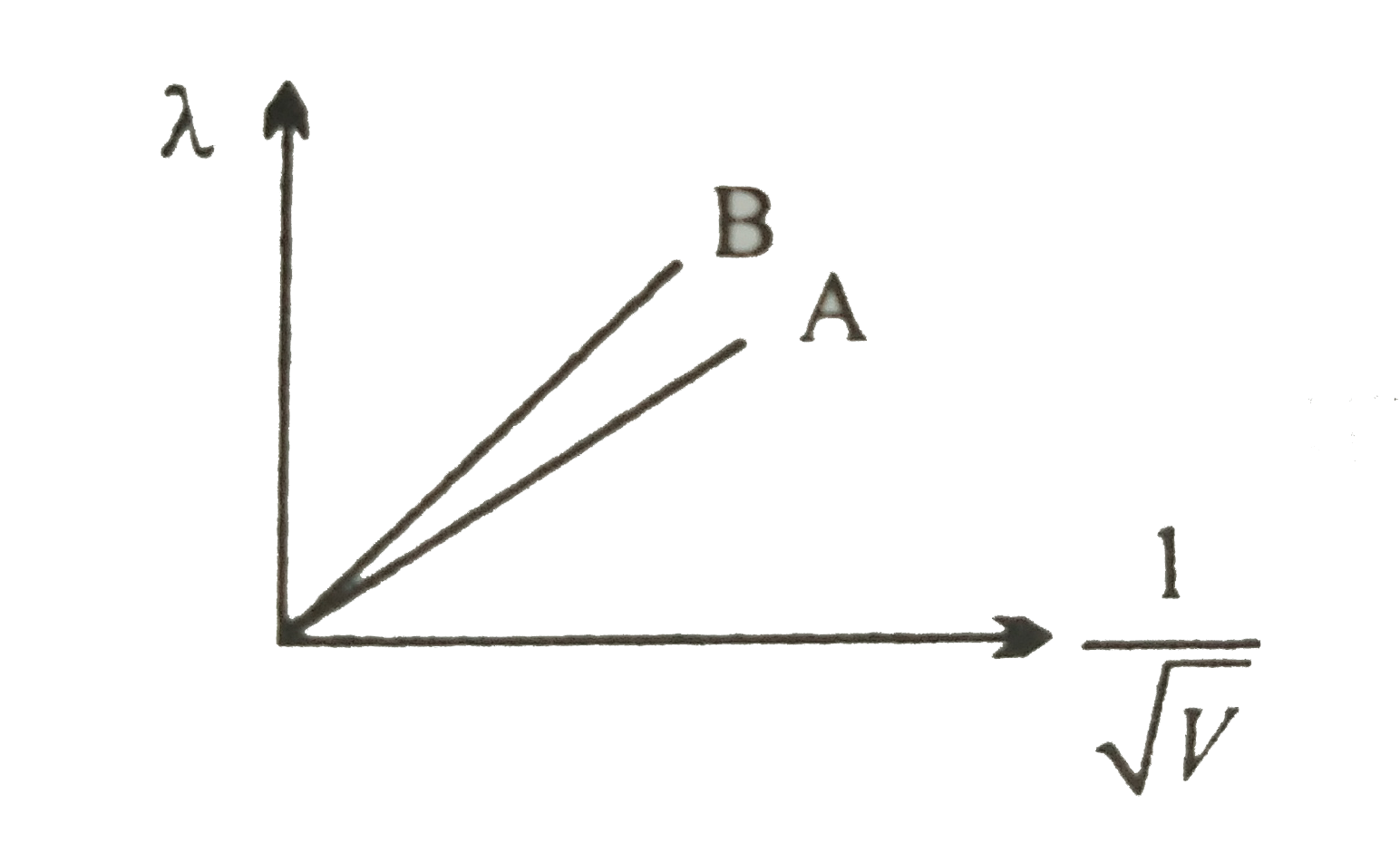Figure shows a plot of where V is the accelerating potential. The de-Broglie wavelength 'λ' in the case of two particles having same charge 'q' but different masses m, and mz. Which line (A or B) represents a particle of larger mass ?
 Solution in Kannada
Solution in Kannada
λ=h√2meV
λA=h√2mAqVA
λB=h√2MeBeVB=h√2MBqVB
√2mBqVB2mAqVA=√mBVBmAVA
λA√VA=λB√VB
mA<mB
Topper's Solved these Questions
- DUAL NATURE OF RADIATION AND MATTERBOOK - OSWAAL PUBLICATIONCHAPTER - DUAL NATURE OF RADIATION AND MATTEREXERCISE - TOPIC-2 DE-BROGLIE RELATION (SHORT ANSWER TYPE QUESTIONS-I)
9 Videos
- DUAL NATURE OF RADIATION AND MATTERBOOK - OSWAAL PUBLICATIONCHAPTER - DUAL NATURE OF RADIATION AND MATTEREXERCISE - TOPIC-2 DE-BROGLIE RELATION (SHORT ANSWER TYPE QUESTIONS-II)
2 Videos
- DUAL NATURE OF RADIATION AND MATTERBOOK - OSWAAL PUBLICATIONCHAPTER - DUAL NATURE OF RADIATION AND MATTEREXERCISE - TOPIC-1 PHOTOELECTRIC EFFECT (NUMERICAL PROBLEMS)
15 Videos
- CURRENT ELECTRICITY BOOK - OSWAAL PUBLICATIONCHAPTER - CURRENT ELECTRICITY EXERCISE - TOPIC-3 (POTENTIOMETER & APPLICATIONS) (NUMERICAL PROBLEMS)
2 Videos
- ELECTRIC CHARGES & FIELDSBOOK - OSWAAL PUBLICATIONCHAPTER - ELECTRIC CHARGES & FIELDSEXERCISE - (TOPIC -2)Numerical Problems
5 Videos
Similar Questions
What are matter waves? Derive an expression for the de Broglie wave length.
View SolutionAn electron and a photon each have a wavelength of 1.00 nm. Find (i) their momentum (ii) the energy of the photon and (iii) K.E of electron
View SolutionThe threshold wavelength of a photosensitive metal is 662.5 nm. If this metal is irradiated with a radiation of wavelength 331.3 nm, find the maximum kinetic energy of the photoelectrons. If the wavelength of radiation is increased to 496.5 nm, calculate the change in maximum kinetic energy of the photoelectrons. (Planck's constant h=6.625×10−34 Js and speed of light in vacuum=3×108ms−1)
View SolutionA resistance of RΩ draws current from a potentiometer. The potentiometer has a total resistance R0Ω.A voltage V is supplied to the potentiometer. Derive an expression for the voltage across R when the sliding contact is in the middle of the potentiometer.

View SolutionAn atom was earlier assumed to be sphere of radius a having a positively charged point nucleus of charge +Ze at its centre . This nucleus was believed to be surrounded by a uniform desity of negative charge that made the atom neutral as a whole.
Use this theorem to find the electric field of this atom at a distance r(r>a) from the centre of the atom.
View SolutionThe two lines A and B in fig. shoe the phot of de Broglie wavelength (lamda) as a function of (1)/(sqrtV) (V is the accelerating potential) for teo particles having the same charge. Which of the two represents the particle of heavier mass?
View Solutionde Broglie wavelengths of two particles A and B are plotted against (1√V) , where V is the potential on the particles. Which of the following relation is correct about the mass of the particles ?

View SolutionTwo lines, A and B, in the plot given below show the variation of de-Broglie wavelength, λ versus 1/√V, where V is the accelerating potential difference, for two particles carrying the same charge. Which one of two represents a particle of smaller mass?

View SolutionDraw a graph showing the variation of de Broglie wavelength of a particle of charge q and mass m with accelerating potential. Proton and deuteron have the same de Broglie wavelengths. Explain which has more kinetic energy.
View Solutionकिसी आवेशित कण का द्रवमान m तथा इस पर आवेश q हैं । कण को V विभवान्तर से त्वरित करने पर सम्बन्ध दी-ब्रोग्ली तरंगदैर्ध्य का सूत्र ज्ञात कीजिए ।
View Solutionकिसी आवेशित कण का द्रवमान m तथा इस पर q आवेश हैं । यदि कण V विभवान्तर से त्वरित किया जाये तो इससे सम्बंधित दी - ब्रोग्ली तरंगदैर्ध्य का सूत्र लिखिए ।
View Solutionद्रव्यमान m तथा आवेश q के एक कण को V विभव द्वारा त्वरित किया जाता है। कण का डी ब्रोग्ली तरंगदैर्घ्य होगा
View SolutionThe de-Broglie wavelength lambda associated with charged particle of charge q, mass m and potential difference V is
View SolutionWrite the expression for the de Broglie wavelength associated with a charged particle having charge q and mass , when it is accelerated by a potential V.
View Solutionदिए गए प्लॉट (Plot) में दो रेखाएँ A और B1√V के विरुद्ध दे ब्रॉग्ली तरंगदैर्घ्य में परिवर्तन को प्रदर्शित करते है, जहाँ V समान आवेश वाले दोनों कणो के लिए त्वरक विभवांतर है। दोनों में से कौन-सी रेखा कम द्रव्यमान वाले कण को प्रदर्शित करती है ।

View Solution
